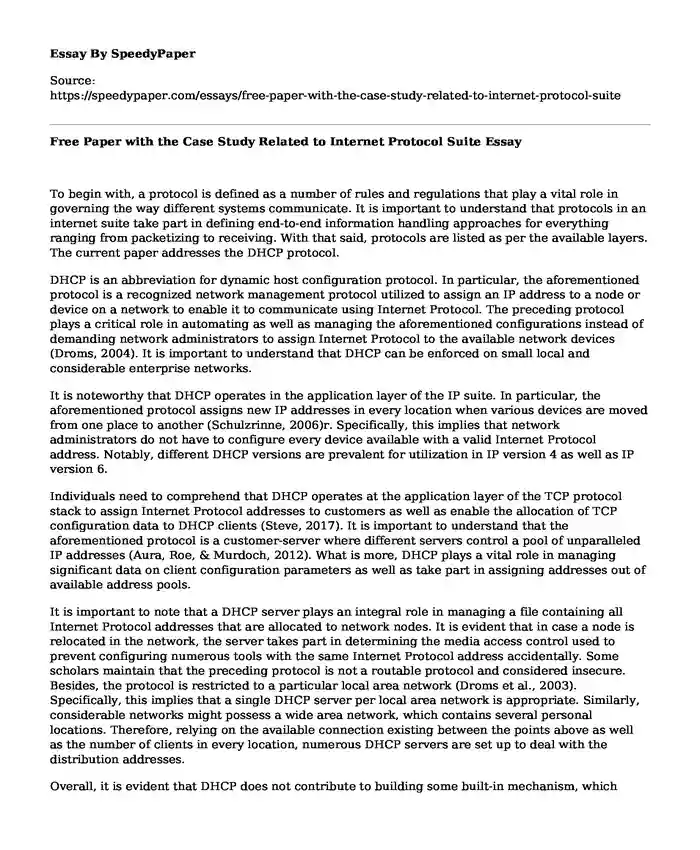
| Type of paper: | Case study |
| Categories: | Computer science |
| Pages: | 3 |
| Wordcount: | 641 words |
To begin with, a protocol is defined as a number of rules and regulations that play a vital role in governing the way different systems communicate. It is important to understand that protocols in an internet suite take part in defining end-to-end information handling approaches for everything ranging from packetizing to receiving. With that said, protocols are listed as per the available layers. The current paper addresses the DHCP protocol.
DHCP is an abbreviation for dynamic host configuration protocol. In particular, the aforementioned protocol is a recognized network management protocol utilized to assign an IP address to a node or device on a network to enable it to communicate using Internet Protocol. The preceding protocol plays a critical role in automating as well as managing the aforementioned configurations instead of demanding network administrators to assign Internet Protocol to the available network devices (Droms, 2004). It is important to understand that DHCP can be enforced on small local and considerable enterprise networks.
It is noteworthy that DHCP operates in the application layer of the IP suite. In particular, the aforementioned protocol assigns new IP addresses in every location when various devices are moved from one place to another (Schulzrinne, 2006)r. Specifically, this implies that network administrators do not have to configure every device available with a valid Internet Protocol address. Notably, different DHCP versions are prevalent for utilization in IP version 4 as well as IP version 6.
Individuals need to comprehend that DHCP operates at the application layer of the TCP protocol stack to assign Internet Protocol addresses to customers as well as enable the allocation of TCP configuration data to DHCP clients (Steve, 2017). It is important to understand that the aforementioned protocol is a customer-server where different servers control a pool of unparalleled IP addresses (Aura, Roe, & Murdoch, 2012). What is more, DHCP plays a vital role in managing significant data on client configuration parameters as well as take part in assigning addresses out of available address pools.
It is important to note that a DHCP server plays an integral role in managing a file containing all Internet Protocol addresses that are allocated to network nodes. It is evident that in case a node is relocated in the network, the server takes part in determining the media access control used to prevent configuring numerous tools with the same Internet Protocol address accidentally. Some scholars maintain that the preceding protocol is not a routable protocol and considered insecure. Besides, the protocol is restricted to a particular local area network (Droms et al., 2003). Specifically, this implies that a single DHCP server per local area network is appropriate. Similarly, considerable networks might possess a wide area network, which contains several personal locations. Therefore, relying on the available connection existing between the points above as well as the number of clients in every location, numerous DHCP servers are set up to deal with the distribution addresses.
Overall, it is evident that DHCP does not contribute to building some built-in mechanism, which would enable customers as well as servers to authentic each other. The aspects mentioned above contribute to deception and to attack and to track. It is noteworthy that under a dynamic DHCP setup, a customer might conduct certain events that contribute to terminating its IP address as well as reconnecting to the network using another Internet Protocol address.
References
Aura, T., Roe, M., & Murdoch, S. (2012). U.S. Patent No. 8,239,549. Washington, DC: U.S. Patent and Trademark Office.
Droms, R. (2004). Stateless dynamic host configuration protocol (DHCP) service for IPv6.
Droms, R., Bound, J., Volz, B., Lemon, T., Perkins, C., & Carney, M. (2003). Dynamic host configuration protocol for IPv6 (DHCPv6) (No. RFC 3315).
Schulzrinne, H. (2006). Dynamic host configuration protocol (dhcpv4 and dhcpv6) option for civic addresses configuration information.
Steve. (2017). The TCP/IP mode and protocol suite explained for beginners. Navigation. Retrieved from http://www.steves-internet-guide.com/internet-protocol-suite-explained/
Cite this page
Free Paper with the Case Study Related to Internet Protocol Suite. (2022, Jun 16). Retrieved from https://speedypaper.net/essays/free-paper-with-the-case-study-related-to-internet-protocol-suite
Request Removal
If you are the original author of this essay and no longer wish to have it published on the SpeedyPaper website, please click below to request its removal:
- Essay Sample for Free: Education Is a Tool of Change
- Free Essay: An Academic Challenge I Can Overcome
- Free Essay Example: Medicine Field of My Choice
- Research in Education with SPSS, Statistics Essay Sample
- Free Essay Sample on Novartis Vaccines
- Free Essay on the Topics of Rape Culture and Feminism
- Paper Example: A Two-Way Statistical Influence
Popular categories




